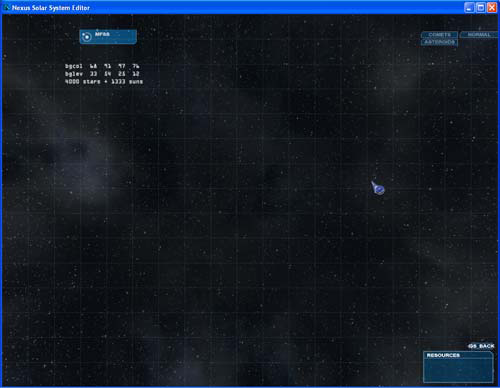Nexus:TJI Creating Solar systems
This page is a 'work in progress' - while this warning is in place, then the guide is not finished.
Creating Solar Systems
In this guide, we going to learn how to create a new solar system from scratch. Now we could simply use a system that someone’s already created, but there’s no fun in that and we are here to learn after all (Besides, it’s part of the mission making tutorial anyway). I’d also just like to take a moment to say thank you to Jusas, for writing the tutorial that I’m using as a foundation for this part. Believe it or not, making a new system is quite simple, just a little time consuming and if you try reading the manual through first, then it can seem quite daunting. Hopefully, this version will be much easier on the eye (and mind!).
Now, before we begin, I’d just like to point out that I do my scripting with notepad, but you’re free to use whatever text editor comfortable for you. So let’s begin…
Our first step is actually a bit of cheating, what we’re going to do is navigate our way through the original campaign files by this path – ‘Nexus - The Jupiter Incident\universe\systems’, where we should find the file ‘sol.system’. Copy this file and place it in the new ‘systems’ file we just created.
So we should be looking at…
Open the sol.system file and you should find yourself looking at this…
Now all we’re really interested in is the first few lines, everything below the first celestial line (and including) can be deleted safely. So let’s get rid of the unwanted stuff and change the name to “My First Solar System”, but as that’s a bit of a mouthful, we’ll abbreviate it to ‘Mfss’ (oh, and don’t be tempted to add ‘system’ to the name, the editor will do this for you!). What we’ll also do, is ‘clear’ the CatalogID field too (I’m not quite sure what this is for to be honest, but it doesn’t seem to affect anything).
So…
This is what we should now be looking at. Believe it or not, that’s about all we need to do with this file, from now on everything we need to do is handled by the Solar System Editor. The only thing we may be required to play around with is the system position, so let me just bring up a picture of the map you’ll soon be looking at…
Ok, now we have this, if you take a look at the .system file you’ve created, you’ll see that the third line of text holds the galactic positional data. The first thing to know is that ‘position 0 0 0’ is the centre of the map. So with that in mind…
- 1) A positive first number will push us ‘east’ while a negative number will pull us ‘west’.
- 2) A positive second number will send us ‘north’ and the negative will take us ‘south’.
- 3) As I can’t really see any difference, I’ll hazard a guess that a positive number will ‘raise’ our systems position and a negative will have the opposite effect (not sure what effect this has in the game, but there we go).
If you wish to, feel free to play around with the positional data and when you’re ready, save and close the file. It’d also be wise to point out that you must save your text files (not necessarily close them) before starting up either of the editors or they will not take any notice of your recent work! You may consider it obvious, but I’ve done it several times and sat there wondering why there’s been no changes in the editor, so be warned.
One last thing before we fire up the editor, rename your .system file to ‘Mfss.sys’ for both your benefit and the games (let’s face it, we’re going to get confused enough in our modding careers so why add to it unnecessarily?).
Ok, let’s start up our system editor! Run the mod_tools.exe from the Nexus\mod_tools folder, select our ‘Tutorial’ from the drop down menu and click on the Solar System Editor. This should now open up the galactic map very similar to the one above with our system somewhere on it (all depends as to whether or not you tinkered with the position), select Mfss.sys with a double click to go into the system view (click again if you get bored with the scenic view) and you’ll be greeted with…
Bit boring huh? So let’s brighten it up… the first thing we’re going to do is add a sun with the following key combination –
CTRL‐SHIFT‐U
Aargh!! Bright lights, bright lights!
Who let those blooming gremlins in here?!
But they do have a point though, the sun we’ve just created may not be just what we want. So let’s change it, by using Numpad + and –, we can change the size or intensity of the sun (depends on your point of view). And with a playing, we can alter the colour (or temperature if you prefer) with Numpad / and *.
So go have a play, I’ll still be here when you get back. Then we can progress to planet creating (isn’t it fun being god of your own universe?).
Finished…? No…? Okey dokey.
Da dee dum dum da, da dee dum.. Well, here’s a few of mine I did while I was waiting…





